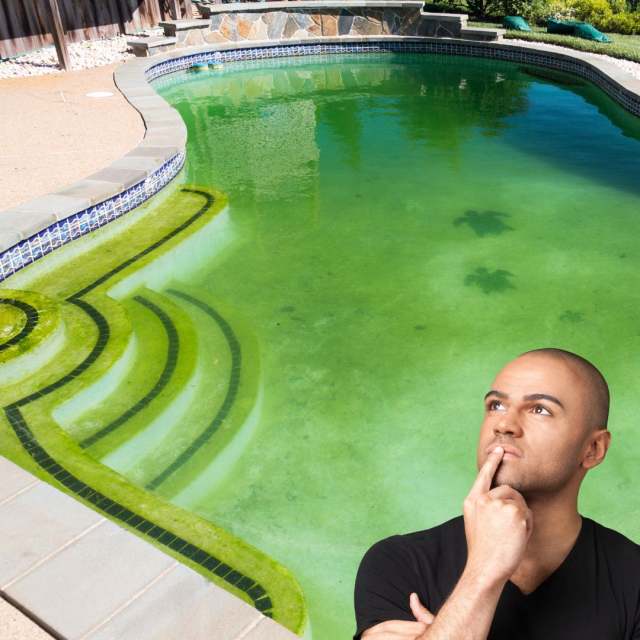Algae in a pool can be a frustrating and unsightly problem for pool owners. These microorganisms, which can appear in various shapes and colors, not only affect the appearance of the pool, but can also be an indicator of water maintenance problems.
Types of Algae in the Pool
Before tackling how to remove algae, it is helpful to understand the different types of algae that can appear in a pool:
Green Algae : They are the most common and can be easily identified by the green color of the water. Green algae cling to the walls and bottom of the pool and can cause the water to become cloudy.
Yellow or Mustard Algae: These algae are less common and have a yellowish or mustard color. They tend to appear in areas with little water circulation and can be difficult to remove.
Black Algae: These are the most difficult to treat and appear as black spots on the walls and bottom of the pool. Black algae have deep roots that adhere firmly to surfaces.
Pink Algae: Although technically not algae, but rather a bacteria, they can appear as pink spots on pool surfaces.
Causes of Algae Appearance
Algae can grow in the pool for several reasons, including:
Lack of Chlorine: Chlorine is the main disinfectant that keeps pool water free of microorganisms. If chlorine levels are low, algae can grow rapidly.
Unbalanced pH: An unbalanced pH can reduce the effectiveness of chlorine and promote algae growth.
Improper Water Circulation: Areas of the pool with poor water circulation are prone to algae growth.
Environmental Conditions: Heat, sunlight, and the presence of organic matter such as leaves and dirt can contribute to algae growth.
Steps to Remove Algae from the Pool
1. Physical Cleaning
The first step to eliminate algae is to physically clean the pool:
Brushing : Use a suitable brush to scrub the walls and bottom of the pool. This will help loosen any algae attached to the surfaces. For black algae, it is advisable to use a metal bristle brush.
Filter Cleaning: Clean or replace the pool filter, as it may be full of algae and other debris.
2. Adjustment of Chemical Levels
Maintaining proper pool chemical levels is crucial to preventing algae growth. Here are the recommended levels:
Chlorine : Maintain a free chlorine level between 1 and 3 parts per million (ppm). During shock treatment, levels may be higher.
pH : The pH should be between 7.2 and 7.6. A lower pH improves the effectiveness of chlorine.
Total Alkalinity: Maintain alkalinity between 80 and 120 ppm to stabilize pH.
Chlorine Stabilizer (Cyanuric Acid): Maintain cyanuric acid levels between 30 and 50 ppm. This product protects chlorine from degradation by UV rays.
3. Shock Treatment
Shock treatment involves adding a high dose of chlorine or a special shock product to destroy algae and other contaminants:
Choosing the Shock Product: There are several types of shock products, such as calcium hypochlorite, sodium hypochlorite and dichlor. Consult a professional to choose the most suitable one for your pool.
Apply Shock: Follow the manufacturer's instructions to apply the shock product. It is advisable to do it at night to avoid the degradation of chlorine by UV rays.
Filter and Circulate: After shock treatment, let the filtration system run for at least 24 hours to remove dead algae.
4. Use of Algicides
Algicides are chemicals designed specifically to kill algae:
Preventive Algaecide: Use a preventive algaecide regularly to prevent algae growth. These products are typically gentle and safe for continued use.
Shock Algaecide: For severe infestations, use a shock algaecide. These products are stronger and can quickly remove algae.
5. Regular Maintenance
Prevention is the key to keeping a pool free of algae. Follow these tips for regular maintenance:
Water Test: Test your pool water at least once a week to make sure chemical levels are within the recommended range.
Regular Cleaning: Brush the walls and bottom of the pool weekly and clean the filter as needed.
Proper Circulation: Make sure the pump and filtration system are working properly and that water is circulating properly throughout the pool.
Remove Debris: Remove leaves, dirt and other debris from the pool regularly to prevent the buildup of organic matter.
Alternative and Natural Solutions
Some pool owners prefer alternative, natural methods for algae control. Here are some options:
Copper-Silver Ionization: This method uses copper and silver ions to eliminate microorganisms and algae. It is a greener option and reduces the need for chemicals.
Hydrogen Peroxide: Hydrogen peroxide is a strong oxidant that can be used as an alternative to chlorine for shock treatment.
Ultraviolet (UV): UV disinfection systems use ultraviolet light to destroy bacteria and algae without chemicals.
Removing algae from your pool and keeping the water crystal clear requires a combination of physical, chemical, and regular maintenance methods. With the right knowledge and the right tools, you can enjoy a clean, algae-free pool all year round. Remember that prevention is always easier than elimination, so adopt a regular maintenance regimen and closely monitor water chemical levels. By following these steps, you can enjoy a healthy and attractive pool for you and your loved ones.
